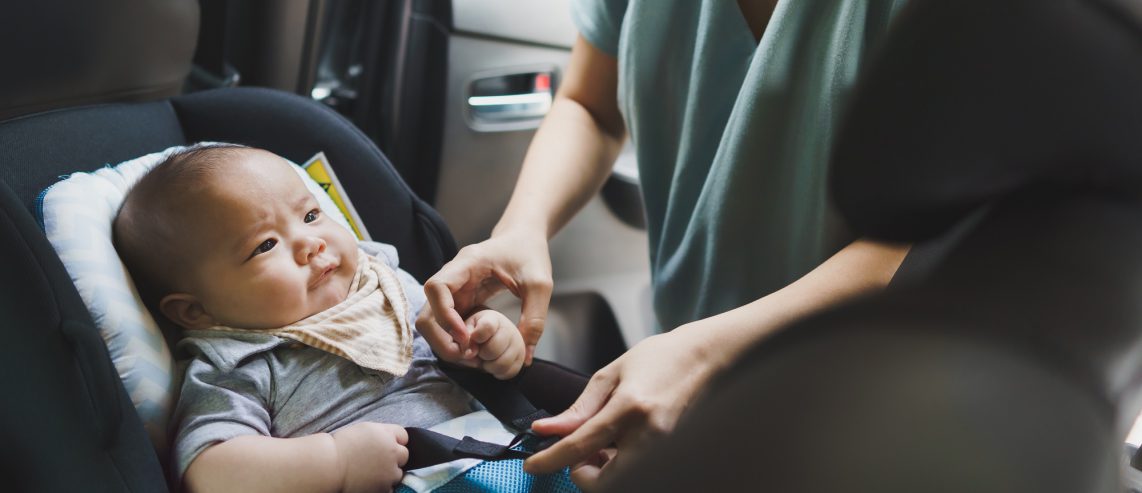You’ve heard it before: The proper use of car seats can help children stay safe in a crash. And babies need to sit in a rear-facing car seat.
There’s one new piece of advice to add: Toddlers and even preschoolers should ride in a rear-facing car seat. It can save their lives if they’re in an accident.
Here’s the latest information about rear-facing car seats.
Your Child Should Always Ride in a Car Seat
First the basics: Car seats save lives and protect children from serious injuries.
The American Academy of Pediatrics (AAP) estimates that car seats reduce the risk of injury by 71–82%, compared with seat belts alone.
For babies and toddlers, riding in a rear-facing seat is especially important. A rear-facing car seat protects a baby’s vulnerable head and spine better than a forward-facing seat.
Never Miss a Beat!
Subscribe to Our HealthBeat Newsletter!
Thank you for subscribing!
You can now select the specific newsletters you'd like to receive.
You are already subscribed.
Subscribe to more newsletters in our email preference center.
Sorry, an error occurred. Please try again later.
Get Healthy Tips Sent to Your Phone!
How Long Do You Keep Car Seat Rear-Facing?
If you’re confused about rear- versus front-facing car seat rules, you’re not alone. And advice from older moms or friends may prove inaccurate. Current AAP recommendations differ from even a few years ago.
The AAP updated its stance on rear-facing car seats in 2018. The current recommendation is to keep your child in a rear-facing seat as long as possible, within the manufacturer’s height and weight limits. (The former advice was to keep babies rear-facing till age 2.)
Fortunately, car seat manufacturers have increased height and weight limits on their rear-facing seats. Children can safely ride rear-facing into their toddler and sometimes preschool years.
Why a Rear-Facing Car Seat?
The simple answer is: It’s safer.
Babies and young children have large heads (compared to the size of their bodies) and a high center of gravity. In a crash, a rear-facing seat cradles the back, neck, and head and helps spread out the force of the crash. It minimizes the risk of serious injuries to the child’s neck, head, and spine.
Rear-Facing Vs. Front-Facing Car Seat
There are three basic types of rear-facing car seats. Which you choose is a matter of personal preference and which suits your lifestyle better.
Infant seats
Infant car seats snap into a base that stays in the car while you carry the baby out in the seat. They can only be rear-facing. Many also snap into a stroller frame, which makes them handy if you’re in and out of the car frequently.
Infant seats typically have a weight limit of 22 to 35 pounds and a height limit of 26 to 35 inches. They are smaller (and therefore lighter) than convertible car seats. They have a carrying handle, so it’s easy to transport baby and seat together.
However, your baby will eventually outgrow an infant seat, and you’ll end up having to buy another, front-facing car seat.
Convertible seats
These seats have higher height and weight limits (usually up to 50 pounds) than infant seats. This allows you to use the same seat for a greater length of time. You can keep your child rear-facing for longer and then turn the seat around when your child is ready.
Convertible seats are heavier and not as portable as infant seats. Most parents choose an infant seat for new babies then move to the convertible seat when the baby is above the height and/or weight limits of the infant seat.
All-in-one seats
In addition to rear-facing and front-facing use, these seats can eventually transform into booster seats as your child grows bigger. They are often more expensive than other car seats because they last until the preteen years.
All-in-one seats are the biggest car seats, so check that the model you choose fits in your vehicle when rear-facing.
More Car Seat Safety Tips
In addition to making sure your child is facing the correct way, here are some other car seat safety tips:
- Never use a car seat that’s been in a crash.
- Always check the weight and height limit on your car seat.
- Don’t use a car seat that’s past its expiration date.
- Follow the manufacturer’s and vehicle manuals when installing the seat.
- Don’t use a car seat as a substitute for a crib or leave a baby unattended in a car seat. When not riding in a vehicle, the baby should not sleep in a car seat.
If you have questions about car seat safety, don’t rely on advice from friends or family. Check with a certified car seat technician, pediatrician or car seat manufacturer. In Pennsylvania, www.pakidstravelsafe.org is a great resource.
Sources
American Academy of Pediatrics, Car Seats: Information for Families, Link
American Academy of Pediatrics, How long should my child ride rear-facing? Link
American Academy of Family Physicians, AAP Updates Car Safety Seat Recommendations for Children, Link
AAP Publications, Child Passenger Safety, Link
CDC, Child Passenger Safety: Get the Facts, Link
About Pediatrics
From nutrition to illnesses, from athletics to school, children will face many challenges growing up. Parents often will make important health care decisions for them. We hope to help guide both of you in that journey. UPMC Children’s Hospital of Pittsburgh is a national leader in pediatric care, ranking consistently on U.S. News & World Report’s Best Children’s Hospitals Honor Roll. We provide expert treatment for pediatric diseases, along well-child visits, urgent care, and more. With locations across Pennsylvania, Maryland, and West Virginia, you can find world-class care close to home. We also work closely with UPMC Magee-Womens Hospital, a national leader in care for newborns and their mothers. Our goal is to provide the best care for your children, from birth to adulthood and beyond. Visit our website to find a doctor near you.
